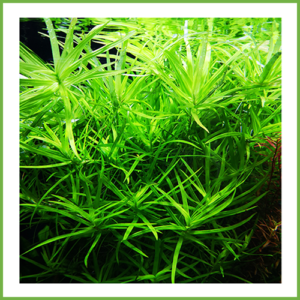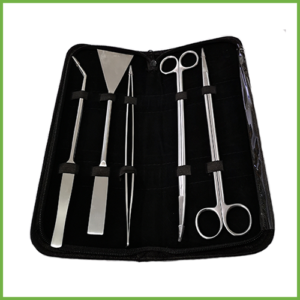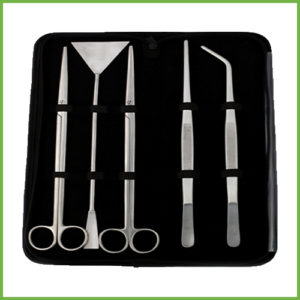Description
Ludwigia Arcuata
Price per stem, grown submerged

Overview
Ludwigia arcuata, commonly known as Needle Leaf Ludwigia, is a vibrant aquatic plant popular in the aquarium trade for its striking red, orange, or green needle-like leaves. Native to North America, particularly wetlands in the southeastern United States, this stem plant adds aesthetic appeal and contributes to a healthy aquarium ecosystem by oxygenating water and absorbing excess nutrients. It’s suitable for both beginner and experienced aquarists, though it thrives best under specific conditions.
Care Requirements
Lighting:
Moderate to high lighting (50–100 µmol PAR) is essential for vibrant coloration and healthy growth. Low light results in greener leaves and leggy growth.
Water Parameters:
- Temperature: 20–28°C
- pH: 5.5–7.5
- Hardness: Soft to moderately hard (2–12 dGH)
Substrate:
Nutrient-rich substrate (e.g., aquasoil or fine gravel with root tabs) promotes robust growth, though it can grow in inert substrates with liquid fertilizers.
Nutrients:
Requires iron, potassium, and trace elements. Regular dosing of liquid fertilizers (e.g., Seachem Flourish or APT Complete) is recommended.
CO2:
Supplemental CO2 (10–30 ppm) enhances growth and coloration, but it can survive without it under high light and nutrient supplementation.
Tank Requirements:
Suitable for tanks as small as 40 litres, but larger tanks allow better growth and aquascaping flexibility.
Planting and Propagation
Planting:
- Trim stems to 10–15cm and plant 2–5cm deep in the substrate, spacing stems 12–5cm apart for a bushy appearance.
- Can be used in midground or background aquascapes due to its 30–40cm height potential.
- Alternatively, it can be floated initially to encourage root growth before planting.
Propagation:
- Cut healthy stems just below a node (where leaves emerge) and replant the cuttings.
- Side shoots can also be trimmed and replanted.
- Ensure cuttings have at least 3–4 nodes for successful rooting.
- Propagation is straightforward and rapid under optimal conditions, with new growth visible within 1–2 weeks.
Maintenance
- Trimming: Regularly trim the top portions to maintain shape and encourage bushier growth. Remove dead or yellowing leaves to prevent decay.
- Water Changes: Perform 25–50% water changes weekly to maintain nutrient balance and water quality.
- Cleaning: Gently rinse leaves during maintenance to remove algae or debris, as delicate leaves can accumulate buildup.
- Monitoring: Watch for nutrient deficiencies (yellowing leaves indicate nitrogen/iron deficiency) and adjust fertilization accordingly.
- Pruning Frequency: Every 2–4 weeks, depending on growth rate, to prevent overcrowding.
Challenges and Tips
Challenges:
- Algae Growth: High light can promote algae on leaves if nutrients are imbalanced. Maintain proper nutrient levels and consider adding algae-eating species like nerite snails or shrimp.
- Melting: New plants may shed leaves when adapting to new tank conditions. Ensure stable parameters and avoid drastic changes.
- Leggy Growth: Insufficient light causes elongated, sparse stems. Increase light intensity or duration (8–10 hours daily).
- Nutrient Sensitivity: Over- or under-fertilization can stunt growth or cause algae blooms. Test water regularly (e.g., with API test kits) to monitor nitrate, phosphate, and iron levels.
Tips:
- Pair with fast-growing plants like Hygrophila or Rotala to outcompete algae for nutrients.
- Use a timer for consistent lighting schedules to mimic natural cycles.
- If CO2 injection isn’t feasible, consider Excel or other liquid carbon supplements for moderate growth boosts.
- Plant in groups of 5–10 stems for a fuller, more dramatic effect in aquascapes.
Recommendation
- Tank Setup: Ideal for planted tanks with moderate to high-tech setups (e.g., with CO2 and strong lighting). Works well in Dutch-style or nature aquariums.
- Companion Species: Pairs well with carpeting plants like Dwarf Hairgrass or Monte Carlo, and contrasts nicely with green plants like Anubias or Java Fern. Compatible with small fish (tetras, rasboras) and invertebrates (shrimp, snails). Avoid large, plant-eating fish like cichlids.
- Beginner-Friendly Option: For beginners, combine with easy-to-grow plants and start with liquid fertilizers before investing in CO2 systems.
- Aesthetic Use: Use Ludwigia arcuata as a focal point in the midground or background, leveraging its red hues to create depth in aquascapes.







